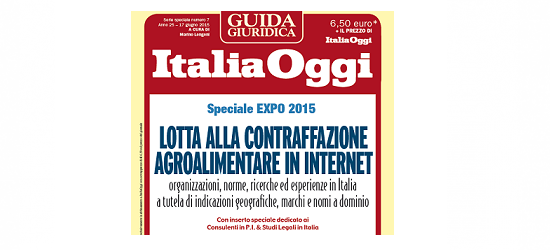
Alessio Canova, Trademark Attorney – GIAMBROCONO & C. Spa, Milan
As known, the Designations of Origin (D.O.), genus to which belongs the species of DOCG (Designations of Origin Controlled and Guaranteed), are not properly “distinctive signs” as trademarks, company, signs and domain names.
In fact, even if there are various common elements with the category of collective trademarks, while this latter, as well as all trademarks in general, grants the owner a real exclusive right, the Designations of Origin are instead “protected” (among others, refer to Article 29 Italian IP Code) but in any case potentially used by any entity having particular requirements.
Common to both categories, trademarks and D.O., is instead the feature of representing the indicator of “origin” of a specific product or service.
For “real” trademarks, the “distinctive capacity” is considered to be the aptitude of “distinguishing goods and services of [“coming from”] a company to those of [“coming from”] other companies” (Article 7 IIPC and, with exactly the same words, Article 4 REG. (CE) no. 207/2009 about community trademark). It is the traditional function of distinctive signs.
On the other hand, for D.O. the “origin” is always a “geographical” one, which means related to a specific land, region or place.
Otherwise said, if it is normal that a trademark belongs to a single entity that, referring to the registered sign, acts in a monopolistic way and is granted an ius excludendi omnes alios, it should be at the same time normal and typical not to exist exclusive rights over D.O.; indeed, they should be characterized by an opposite freedom of use for all persons/companies having the necessary requirements.
What above mentioned is surely true with reference to traditional economy, while ends to be like this in the “new economy”.
It is in fact sufficient a check on the WHOIS database of the various registration authorities to see that the domain names corresponding (or in any case more similar) to the 73, in Italy officially recognized, DOCG don’t quite always belong to the Association to which it is demanded the relative protection but often to single persons who have nothing to do with the corresponding geographical territory.
Without analyzing specific cases, the general background is varied and discouraging: quite all second-level domain names with the “extension” (ccTLD) .IT are registered by entities who simply seem mere speculators and not actually used in connection to active websites.
On the contrary, some of the “registrants” seem to have specifically targeted the domain names corresponding to DOCG.
Clearly said: the above mentioned policy is, in the actual legislative panorama, absolutely legal. In fact, not existing a single person who can claim exclusive rights on DOCG, everybody can actually register the corresponding second-level domain name with the only limit of respecting the “first come, first served” principle.
The practical consequence is however paradoxical. While, on the one hand, the judicial system considers the existence of DOCG, which, being also D.O., are indeed “protected” and should be freely used by all owners of specific requirements, on the other hand, it happens instead that on the Internet single persons, quite always lacking of any type of connection to the corresponding geographical territory, have technically monopolized a DOCG by registering its specific second-level domain name.
Is there any possible solution? Perhaps there is. In fact, the “Assignment and Management Regulation of domain names in the ccTLD .it” already considers at par. 3.4 the existence of some domain names to be defined as “Reserved domain names assigned only to specific categories”, as for example the domain names corresponding to Italian regions, provinces and districts (for example: lazio.it, pisa.it and so on). Why not including in this list also the 73, in our country officially recognized, DOCG and make sure that the corresponding domain names could be registered and used only by their specific producers Associations?
